Hi my readers, I am Rameshini a/p Uthayakumar (197519), 22 years old. I was born in Seremban, Negeri Sembilan on 25th of November. Currently, i am doing degree in Bachelor of International Business Management at University Utara Malaysia. Nothing much to say about me... I am a simple lovely girl who loves god, parents and the person i love...
The Indian Community World
This blog is all about our indian community.
Indian Music
Sitar
Sitar is of the most popular music instruments of North India. The Sitar has a long neck with twenty metal frets and six to seven main cords. Below the frets of Sitar are thirteen sympathetic strings which are tuned to the notes of the Raga. A gourd, which acts as a resonator for the strings is at the lower end of the neck of the Sitar. The frets are moved up and down to adjust the notes. Some famous Sitar players are Ustad Vilayat Khan, Pt. Ravishankar, Ustad Imrat Khan, Ustad Abdul Halim Zaffar Khan, Ustad Rais Khan and Pt Debu Chowdhury.
Sarod
Sarod has a small wooden body covered with skin and a fingerboard that is covered with steel. Sarod does not have a fret and has twenty-five strings of which fifteen are sympathetic strings. A metal gourd acts as a resonator. The strings are plucked with a triangular plectrum. Some notable exponents of Sarod are Ustad Ali Akbar Khan, Ustad Amjad Ali Khan, Pt. Buddhadev Das Gupta, Zarin Daruwalla and Brij Narayan.
Sarangi
Sarangi is one of the most popular and oldest bowed instruments in India. The body of Sarangi is hollow and made of teak wood adorned with ivory inlays. Sarangi has forty strings of which thirty seven are sympathetic. The Sarangi is held in a vertical position and played with a bow. To play the Sarangi one has to press the fingernails of the left hand against the strings. Famous Sarangi maestros are Rehman Bakhs, Pt Ram Narayan, Ghulam Sabir and Ustad Sultan Khan.
Flute
Flute is a simple cylindrical tube of uniform bore and associated with Indian music since time immemorial. Flutes vary in size. Flute is held horizontally and is inclined downwards when it is played. To produce sound or melody one has to cover the finger holes with the fingers of the left and right hand. Variations in pitch are produced by altering the effective length of the air column. Notable flute exponents are Pt Pannalal Ghosh and Pt Hari Prashad Chaurasia.
Shehnai
Shehnai is a traditional musical instrument, associated with auspicious occasions like marriages and temple processions. Shehnai is a double reed instrument with a tapering bore which progressively increases towards the lower side. The Shehnai has finger-holes to produce semi, quarter and micro-tones. Ustad Bismillah Khan is the unrivalled maestro of the Shehnai.
Tabla
The most popular musical instrument used in North India is the Tabla. The Tabla consists of a pair of drums- the Tabla and the Bayan. The Tabla is made of wood and whereas its head is made of stretched animal skin. Finer tuning of Tabla is done by striking the rim of the Tabla with a small hammer. The Bayan is the bass drum and is usually made of metal with a stretched skin head. Both drums have a black spot in the center made of manganese or iron dust.
Pakhawaj
It is believed that the Tabla was derived from Pakhawaj. Pakhawaj usually accompanies Dhrupad style of singing. Pakhawaj is a barrel-shaped drum with two heads which are made of layers of skin. The heads of Pakhawaj are expanded by leather straps which run along the sides of the body over small cylindrical wooden blocks that are used for tuning.
Harmonium
The harmonium is a traditional and popular musical instrument of India. The harmonium has a keyboard of over two and one-half octaves and works on a system of bellows. The keyboard is played with the right hand while the left hand is used to operate the bellows. Harmonium is more popular in North India than in the South.
Jaltarangam
Jaltarangam consists of a set of eighteen porcelain cups of varying sizes. The cups are arranged in a semi-circle before the performer, in decreasing order of size. The largest cup is to the left of the performer whereas the smallest to his right. Water is poured into the cups and the pitch is changed by adjusting the amount of water in the cup. The cups are struck with two thin bamboo sticks.
Mridangam
The mridangam is one of the most popular classical instruments of South India. Mridangam accompanies vocal, instrumental and dance performances. The present day mridangam is made of a single block of wood. It is a barrel-shaped double-headed drum, the right head being smaller than the left. The two heads are made of layers of skin. The mridangam is played with hands, palms and fingers.
Ghatam
The Ghatam is one oldest percussion instruments of South India. The Ghatam is a mud pan with a narrow mouth. From its mouth, it slopes outwards to form a ridge. Ghatam is made mainly of clay baked with brass or copper filings with a small amount of iron filings. The Ghatam produces fast rhythmic patterns. Ghatam is generally a secondary percussion instrument accompanying mridangam.
Sitar is of the most popular music instruments of North India. The Sitar has a long neck with twenty metal frets and six to seven main cords. Below the frets of Sitar are thirteen sympathetic strings which are tuned to the notes of the Raga. A gourd, which acts as a resonator for the strings is at the lower end of the neck of the Sitar. The frets are moved up and down to adjust the notes. Some famous Sitar players are Ustad Vilayat Khan, Pt. Ravishankar, Ustad Imrat Khan, Ustad Abdul Halim Zaffar Khan, Ustad Rais Khan and Pt Debu Chowdhury.
Sarod
Sarod has a small wooden body covered with skin and a fingerboard that is covered with steel. Sarod does not have a fret and has twenty-five strings of which fifteen are sympathetic strings. A metal gourd acts as a resonator. The strings are plucked with a triangular plectrum. Some notable exponents of Sarod are Ustad Ali Akbar Khan, Ustad Amjad Ali Khan, Pt. Buddhadev Das Gupta, Zarin Daruwalla and Brij Narayan.
Sarangi
Sarangi is one of the most popular and oldest bowed instruments in India. The body of Sarangi is hollow and made of teak wood adorned with ivory inlays. Sarangi has forty strings of which thirty seven are sympathetic. The Sarangi is held in a vertical position and played with a bow. To play the Sarangi one has to press the fingernails of the left hand against the strings. Famous Sarangi maestros are Rehman Bakhs, Pt Ram Narayan, Ghulam Sabir and Ustad Sultan Khan.
Flute
Flute is a simple cylindrical tube of uniform bore and associated with Indian music since time immemorial. Flutes vary in size. Flute is held horizontally and is inclined downwards when it is played. To produce sound or melody one has to cover the finger holes with the fingers of the left and right hand. Variations in pitch are produced by altering the effective length of the air column. Notable flute exponents are Pt Pannalal Ghosh and Pt Hari Prashad Chaurasia.
Shehnai
Shehnai is a traditional musical instrument, associated with auspicious occasions like marriages and temple processions. Shehnai is a double reed instrument with a tapering bore which progressively increases towards the lower side. The Shehnai has finger-holes to produce semi, quarter and micro-tones. Ustad Bismillah Khan is the unrivalled maestro of the Shehnai.
Tabla
The most popular musical instrument used in North India is the Tabla. The Tabla consists of a pair of drums- the Tabla and the Bayan. The Tabla is made of wood and whereas its head is made of stretched animal skin. Finer tuning of Tabla is done by striking the rim of the Tabla with a small hammer. The Bayan is the bass drum and is usually made of metal with a stretched skin head. Both drums have a black spot in the center made of manganese or iron dust.
Pakhawaj
It is believed that the Tabla was derived from Pakhawaj. Pakhawaj usually accompanies Dhrupad style of singing. Pakhawaj is a barrel-shaped drum with two heads which are made of layers of skin. The heads of Pakhawaj are expanded by leather straps which run along the sides of the body over small cylindrical wooden blocks that are used for tuning.
Harmonium
The harmonium is a traditional and popular musical instrument of India. The harmonium has a keyboard of over two and one-half octaves and works on a system of bellows. The keyboard is played with the right hand while the left hand is used to operate the bellows. Harmonium is more popular in North India than in the South.
Jaltarangam
Jaltarangam consists of a set of eighteen porcelain cups of varying sizes. The cups are arranged in a semi-circle before the performer, in decreasing order of size. The largest cup is to the left of the performer whereas the smallest to his right. Water is poured into the cups and the pitch is changed by adjusting the amount of water in the cup. The cups are struck with two thin bamboo sticks.
Mridangam
The mridangam is one of the most popular classical instruments of South India. Mridangam accompanies vocal, instrumental and dance performances. The present day mridangam is made of a single block of wood. It is a barrel-shaped double-headed drum, the right head being smaller than the left. The two heads are made of layers of skin. The mridangam is played with hands, palms and fingers.
Ghatam
The Ghatam is one oldest percussion instruments of South India. The Ghatam is a mud pan with a narrow mouth. From its mouth, it slopes outwards to form a ridge. Ghatam is made mainly of clay baked with brass or copper filings with a small amount of iron filings. The Ghatam produces fast rhythmic patterns. Ghatam is generally a secondary percussion instrument accompanying mridangam.
Tradisional Games
Games hold a mirror to civilization
The very word "GAME" is a universal one and does not have any cultural or linguistic boundaries. Games appear to be the common property of people who know them either professionally or as an amateur.
Games are essential for the growth of a man right from his childhood. The child at its infancy likes simple expressive games, which mould him into the concept of leadership, and gives him the sense of victory and defeat. The school games give the advantage of socializing with members of various teams, be it of the same class or the same school or inter-schools. There are games for both indoors and outdoors. Certain games like the game of CHESS give intellectual training for the player, as it reconstructs the battle-field, and gets him the task of strategy management and foresight.
Though the method of playing a particular game has remained unchanged, the symbolism is often influenced by contemporary events. For e.g., during Emperor Napoleon's time, chess sets were made showing Napoleon as the King. Games of pure wit have intrigued men and women from ancient times.
Many of the spiral games were produced during the 18th and 19th centuries as a means of teaching children history, geography, botany and other subjects. Most primitive games are known in almost all parts of the world but their variations tell us about the nature of the people of that particular region.
The permanent fascination of games lies simply in the pure joy of playing. It is this tangible pleasure that distinguishes the true game from the professional sport. Nowadays the players are involved in a cut throat competition when many a time the national prestige is at stake. The light-hearted joy of games has given way to competition and it would not be good unless it remains a healthy one.
In hot or cold climes, in open spaces or countryside or crowded city, slums, streets, children jump, run, hide, chase each other, play, sing and laugh, and this illustrates the universality of games. By means of games, the child is engaged not only in self-discovery, explorative and experiments with its senses, but also understands its relation with the concept of Universe. They gradually learn to get along with the big world outside. Games reflect the ideas and the personality of the child as a whole. Children get many benefits by means of games. There is an opportunity for the growth of the mind. There is a way to use the senses in the right way. One gets the opportunity to mingle with people of the same age, of the same cadre and same ambitions and desires. This helps in developing a social sense and the habit of working cooperatively.
Games are designed to provide fun and entertainment. Physical movements have great importance in the life of any individual. The overall development of the person depends on the physical movements exercised. Through games, children also tend to learn their language. They love to sing or hear songs during the act of playing and hence its power to understand language develops.
Among the rural population of northern India, wrestling, Kabaddi and other indigenous games are popular. Some cowherd caste people both in the north and the south are known for their skills in Lathi and Pikestaff play. Games with balls were introduced from the West to India, which includes football, volleyball and hockey, and some like the Polo were introduced from the East. Cricket still remains a favorite with the Indian populace despite its players being entwined in scam after scam. Curiosities like cockfighting, and fighting of bulbuls and rams are still popular in some communities and areas.
Indian Customes
India has a rich and varied Costume. Traditional costumes in India vary widely depending on the climate and natural fibers grown in a region. Usually the clothes are suitable for the particular regions climate and overall comfort. In the cold northern state of Jammu and Kashmir, people wear a thick loose shirt called a phiran to keep them warm. In the tropical warmth of south India, men wear a sarong like garment called the mundu, while women drape 5 meters of cloth around their bodies in the graceful folds of the saree, the national dress of Indian women. , where each region has its own unique native costume and traditional attire. Indian costume is popular for its colorfulness and grace. The uniqueness of Indian culture lies in it.
Dhoti, a cloth-piece covering the lower part of the body from the waist, is a kind of traditional drapery, bearing the signature of the heritage of Indian costumes. This single piece of rectangular stitchless cloth , measuring about 5 yards in length, can give a man an air of elegance, inherent to his culture.Dhoti is known by different names in various languages. Punjabis call it Laacha , Malayalamis , the Mundu , Bengalis, the Dhuti , The Tamilians, refer it as Vaetti, people of Telegu, the Pancha, Marathis, the Dhotar and those of Kannada , pronounce it as Panche.
 This page on Indian Costume provide you with an elaborate information on the etymology of the word Uttariya and its uses.Uttariya is a piece of cloth used in ancient India to cover the upper part of the body. It used to hang from the neck to drape over the arms. The uttariya was worn in several ways to suit the comforts of the wearer: very elegantly by those at court, who drape it on both shoulders or one shoulder, or diagonally across the chest and casually knotted at the waist, or it could even be worn loosely across the back and supported by the elbows or wrist, and in many other ways according to the whims of the weather.
This page on Indian Costume provide you with an elaborate information on the etymology of the word Uttariya and its uses.Uttariya is a piece of cloth used in ancient India to cover the upper part of the body. It used to hang from the neck to drape over the arms. The uttariya was worn in several ways to suit the comforts of the wearer: very elegantly by those at court, who drape it on both shoulders or one shoulder, or diagonally across the chest and casually knotted at the waist, or it could even be worn loosely across the back and supported by the elbows or wrist, and in many other ways according to the whims of the weather.India has been known to have wonderful dresses and costumes.In the state of Maharashtra, the traditional costume sari is nine yard long. The sari measuring nine-yards in length, and is thus known as Nauvari. The halo of history round the Nauvari sari, stresses on the ethnic value of the costume. It is said, that women, living in Maratha Empire, had demonstrated their caliber. In crucial times of war, they used to assist their fellow male warriors. That was why, in order to become accomplished in their mission, these valorous Indian women, invented this characteristic Maharashtrian style of dressing in a sari. Nauvari Sari is one of the important indian costume popular among the women.
Yoga
The asanas in this section are the basic poses that every yoga practitioner is supposed to know. It isn't the same as simply learning the mechanics of swinging some little league bats, it can take practice. The basic poses are to be learned in the sequence presented. They are arranged in the approximate order of difficulty. Each new pose can be taken a new day. The basic poses are:
Lotus (Sukhasana) | ||
Mountain Pose (Tadasana) | ||
Balance Posture(Natarajasana) | ||
Back Stretch (Paschimottanasana) | ||
Cobra(Bhujaangasana) | ||
Simple chest Expansion(Ardha Chakrasana) | ||
Simple Triangle (Trikasana) | ||
Leg Clasp (Padahastasana) | ||
Bow (Dhanurasana) | ||
Simple Spinal Twist (Ardha Matsyendrasdana) | ||
Backward Bend (Supta Vajrasana) | ||
Knee and thigh Stretch (Bhadasana) | ||
Plough(Halasana) | ||
Shoulder Stand(Sarvangasana) | ||
Simple Fish (Matsya) | ||
Simple Locust (Salabhasana) | ||
Deep Relaxation (Savasana) | ||
LOTUS (SUKHASANA)
- Place your hands on your knees, palms up. Hold as long as you wish.
- This is one of the meditative postures. It imitates an inverted lotus flower. The head is held erect and the eyes closed during this posture.
This promotes balance and harmony.
MOUNTAIN POSE (TADASANA)
- Stand in an erect position with your feet together. Press the feet flat against the floor as if to stretch them.
- Visualize a string through the spine pulling you upward, lifting the knees, hips and hamstrings.
- Equally distribute the body weight. Keep your abdomen in and chest high. Your arms may remain at your sides.
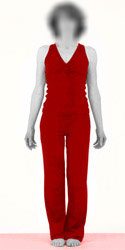
This is a basic posture of balance and control. It is the foundation for good standing posture.
BALANCE POSTURE (NATARAJASANA)
- Stand in the mountain pose. Inhale slowly and raise arm overhead.
- At the same time, lift your left ankle behind you and clasp it with your left hand. Shift your weight to the right side.
- Exhale and pull the left leg toward your body and lean forward slightly while looking forward.
- Your right arm will provide balance. Hold for 20 seconds. Slowly release and return to start. Repeat to opposite side.
This improves balance, coordination and quadriceps flexibility.
BACK STRETCH (PASCHIMOTTANASANA)
- Get into a seated position with legs extended forward.
- Rest your hands on your thighs and straighten your spine.
- Raise your arms in front of you to shoulder level.
- Then proceed to raise them overhead, bending slightly backward.
- Bend forward to your knees.
- Grab your knees and hold the stretch for 10 seconds.
- Your head should be bent forward.
- Pull your body forward to your knees with the elbows bent outward. Hold for 10 seconds.
- Return to upright position.
- Place hands on your thighs and relax.
This increases spinal flexibility and strengthens the back.
COBRA (BHUJANGASANA)
- Lie face down with arms at sides and head resting on either side.
- Slowly bring your head to center and rest your forehead on the floor.
- Place your hands underneath your shoulders with your fingertips facing inward.
- Tilt your head backward and begin raising your trunk. Push your hands against the floor and slowly start straightening your arms. Hold extreme position for 10 seconds.
- Slowly tilt your head forward and lower your trunk back to start. Relax and concentrate on the feeling in the legs, back and abdomen.
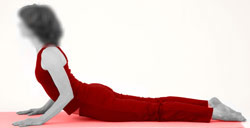
This removes tension from the spine and back, strengthens and firms the abdomen and buttocks.
SIMPLE CHEST EXPANSION (ARDHA CHAKRASANA)
- Get into a standing position, arms at sides.
- Your feet should be approximately six inches apart. Relax your spine.
- With your palms facing outward, raise your arms until they are in front of your chest, elbows bent.
- Straighten your arms. Then slowly bring them behind you, keeping them raised high. Interlock your fingers. Concentrate on the stretch in the shoulders and chest.
- Slowly bend backward. Maintain balance and control. Look upward and hold for 10 seconds.
- With knees locked, bend forward and bring your arms over your back. Hold for 10 seconds.
- Return to upright position. Unclasp your hands and concentrate on relaxing the neck, spine and shoulders.
This strengthens and tones the muscles of the chest, back and arms. The rib cage expansion aids respiration.
SIMPLE TRIANGLE (TRIKONASANA)
- Stand with feet wide apart.
- Slowly raise arms to sides until they reach shoulder level. Your palms should be facing down.
- Exhale and bend left until you can bring your left hand to your left knee.
- Keep your knees locked. Inhale and bring your right arm over as far as possible without bending the elbow. Hold the position for 20 seconds while breathing deeply and concentrating on the stretch.
- Slowly straighten and return to start.
- Relax for a moment, and then repeat to opposite side.
This trims the waistline, relieves tension in the neck and back.
LEG CLASP (PADAHASTASANA)
| |
- Stand in the mountain pose.
- Bend forward. Bring your arms behind your knees and clasp your hands.
- Be certain to position your hands securely behind your knees and slowly draw your upper torso down as far as comfortable. Your head should be lowered and directed toward your knees. Hold for 10 seconds.
- Lower hands to calf level. Again draw your body inward. Hold for 10 seconds.
- Unclasp your hands, inhale deeply and raise your trunk back to start, one vertebra at a time.This tones and firms the thighs and calves. It also improves hamstring flexibility.
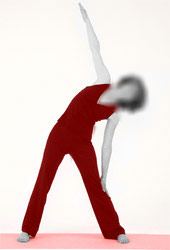
BOW (DHANURASANA)
| |
- Lie on your stomach, arms at sides and chin resting on the floor. Bend your knees, feet together.
- Reach your arms back and grasp your ankles. Slowly raise your torso while arching your back until the abdomen bears the bodyweight. Tilt your head back and hold for 10 seconds.
- Slowly lower until chin is resting on the floor. Release your grasp and lower feet to the floor.
- Lie flat with head turned to one side. Rest and observe the feeling in the pelvic region, back, arms and legs.
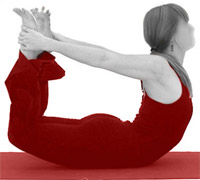
This shapes and tones hips, thighs, buttocks and abdomen. It strengthens lower back and promotes flexibility in the chest, shoulders, back and arms.
SIMPLE SPINAL TWIST (ARDHA MATSYENDRASANA)
- Sit on the floor. Place your right sole against your left thigh.
- Cross your left foot over the right knee and place the sole of your foot firmly on the floor.
- Position your left hand before you.
- Bring your right arm to your left knee and firmly grasp it.
- Slowly twist your trunk and head to the left. Your left arm will then be placed around your waist and rested on your right side. Keep your chin close to your shoulder. Hold for 10 seconds.
- Slowly move our of the posture and relax. Change leg position and repeat to other side.

This releases tension from the spine and promotes spinal flexibility.
BACKWARD BEND (SUPTA VAJRASANA)
- Sit on the back of your heels with your feet close together.
- Slowly move your arms backward, and then place them securely on the floor behind you.
- Drop your head backward while inhaling and expanding your rib cage. Arch your spine. Hold extreme position for 15 seconds. Walk hands forward and return to start.
- Relax for 10 seconds and repeat.
This increases flexibility in ankles, feet and spine. It also strengthens the abdomen and lower back.
KNEE AND THIGH STRETCH (BHADRASANA)
- Get into a seated position.
- Pull your heels into your groin area and grasp your feet. Keep your spine straight.
- Slowly lower your knees.
- Hold extreme position for 10 seconds.
This firms the thighs and promotes knee and inner-thigh flexibility.
PLOUGH (HALASANA)
| |
- Lie flat on your back with arms at your sides. Your palms should be facing down.
- Slowly raise your legs. Use your hands to push against the floor as you lift your trunk. Continue lifting until your legs are lowered beyond your head with your toes touching the ground as near to the head as possible.
- Once you have moved as far as comfortable, press your chin against your chest.
- Place your hands on your back with elbows on the ground. Hold for 20 seconds.
- Slowly unroll back to a lying position. Press your hands against the floor for support of your body weight.
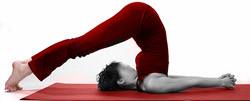
This promotes spinal flexibility and deep relaxation of all the muscles. It also improves the functioning of the internal organs by supplying them with extra blood.
SHOULDER STAND (SARVANGASANA)
| |
- Lie flat on your back.
- Place your hands at your sides, palms down, and begin to raise your legs. Press your hands against the floor to push your legs upward.
- Place your hands on hips, elbows on the ground. Try to straighten your legs and hold them upward. Your chin should be tucked in against your chest. Close your eyes and relax. Hold for 10 seconds.
- Bend your knees, release your hands, and slowly return to start, one vertebra at a time.
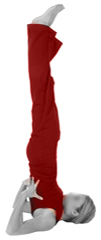
This promotes circulation in chest and neck. It is also said to stimulate the glands, in particular the thyroid.
SIMPLE FISH (MATSYA)
- Lie down, face up, with your legs crossed as in the Lotus posture.
- Cross arms over and around your head. Let your body weight drop naturally.
- Do not force the position. Breathe naturally and hold as long you wish.
- Change leg position and repeat.

This loosens shoulders and hip joints and relaxes the body.
SIMPLE LOCUST (SALABHASANA)
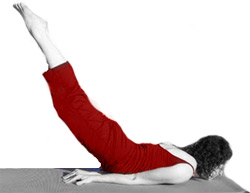 Lie on the floor, face down. Rest your chin on the floor and place your hands at your sides. Make a fist with each hand and place them firmly against the floor at approximately thigh level. Raise your left leg slowly while pushing against the floor with your fists. Raise as high as comfortable. Hold for 10 seconds. Lower leg to ground. Relax for sometime. Raise your right leg and follow the same procedure. This strengthens the abdomen, buttocks and lower back.
Lie on the floor, face down. Rest your chin on the floor and place your hands at your sides. Make a fist with each hand and place them firmly against the floor at approximately thigh level. Raise your left leg slowly while pushing against the floor with your fists. Raise as high as comfortable. Hold for 10 seconds. Lower leg to ground. Relax for sometime. Raise your right leg and follow the same procedure. This strengthens the abdomen, buttocks and lower back. DEEP RELAXATION (SAVASANA)
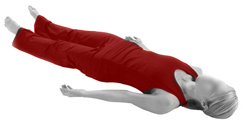 Lie flat on the floor, face up, with arms at the sides. Lie motionless and observe your breathe. Study the flow of breath and quiet your mind. Feel a relaxing force move slowly up the body. It starts at the toes and moves slowly to the ankles, calves, knees and so on. Visualize a quiet stream of gentle energy removing tension from your body. Roll to your side and sit up and observe the feeling of deep relaxation.
Lie flat on the floor, face up, with arms at the sides. Lie motionless and observe your breathe. Study the flow of breath and quiet your mind. Feel a relaxing force move slowly up the body. It starts at the toes and moves slowly to the ankles, calves, knees and so on. Visualize a quiet stream of gentle energy removing tension from your body. Roll to your side and sit up and observe the feeling of deep relaxation. This invigorates the body and mind through conscious relaxation.
Indian Jewellery
One of the most popular looks in Indian jewelry is the silver and gold bangles that can drape beautifully down a woman's arm. Whether the full length of the arm is covered or a few hoops dangle delicately from the wrist, Indian bangles jewelry are definitely one of the most coveted looks around the world. These pieces are also known for being made of some of the highest quality in the world.
Take a closer look and you'll be amazed at how something so ornate can also be made of some of the strongest material and most detailed craftsmanship that can't be found anywhere else in the world.
Wedding day is a very special occasion in every ones life in Asian culture. All girls wanted to look the most beautiful and attractive in her wedding day. And why not? she should be.. after all, its the day of the bride. Lots of people come to attend the ceremony they all collect for the bride and groom.
Take a closer look and you'll be amazed at how something so ornate can also be made of some of the strongest material and most detailed craftsmanship that can't be found anywhere else in the world.
The beauty of Indian gold plated imitation jewelry is another one of India's most famous looks. Whether wearing a large, chunky ring, a thin beaded gold necklace, a wide choker necklace, or a thin draping across the wrist, detecting the authentic look of Indian gold jewelry is not difficult. Indian gold jewelry is often adorned and embellished with orange, aqua green or other brightly colored kundan. This bold look is not only one of the most stylish trends in Indian jewelry, but it also adds a great punch to already fabulous jewelry!
Indian jewellery plays a prominent role in the daily life of every Indian woman.
A married woman is required to wear special necklace, nose ring, bangles, earrings and finger rings. Some customs and traditions also insist that she wears toe rings.
Groom also receives the special treatment on the wedding day but the brides receives more care than the groom, like the dress, makeup and specially the jewellery of the bride holds the great attention of the guests.
Subscribe to:
Posts (Atom)






















